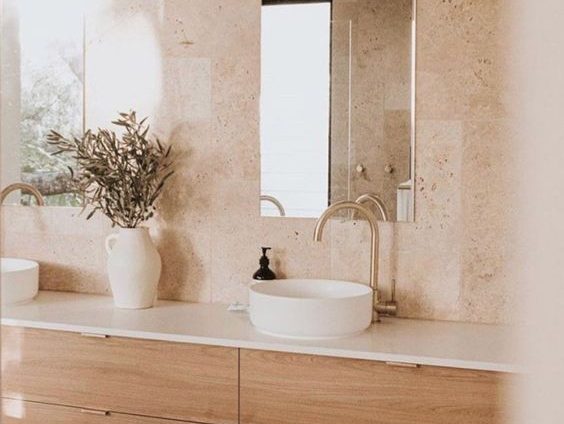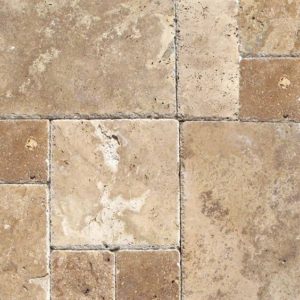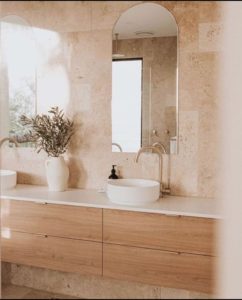
- By: blogger
- Tags: affordable, attractive, best, brushed, cheap, clean, durability, durable, flooring, how to, lifestyle, low-maintenance, must-read, neutral tones, pakistan, polished tiles, stone, style, tile flooring, tiles, tone, travertine, travertine tile, warm toned tiles
- Category: Uncategorized
- 0 comment
You’re missing out on one of the hottest and most elegant interior design trends if you haven’t heard of travertine tile! But don’t worry; we’ll quickly get you caught up. Read on to find out everything you need to know about travertine tile and stone flooring.
One of the most common types of stone used in construction is travertine. It is a sort of limestone created from calcium carbonate deposits in or near hot springs or limestone caves. Travertine is now valued highly as a strong, attractive material for home uses. Such as flooring, backsplashes, shower and bathtub surrounds, fireplace, outdoor pavers for terraces and pathways, and around swimming pools. As opposed to granite and marble, has a naturally faded appearance that complements both informal and formal décor styles. It can offer your place a stunning new look if you’re ready for a home renovation in 2022.
Tones:
Ivory, gold, beige, brown, rust, and peach are just a few of the warm and calming neutral colors you may find in travertine stones, slabs, and tiles. Typically, the color swirls and waves throughout the stone, creating unique patterns that give travertine its timeless beauty. What you won’t see in travertine is dramatically contrasted black veins on a lighter background, which is typical of marble, or brightly colored blotches and freckles, which are characteristics of granite. The majority of travertine, as opposed to those other well-liked stones, contains tone-on-tone color and patterns.
The surface of this tile is typically somewhat pitted with tiny holes and indentations due to the bubbling of carbon dioxide up and out of the stone during its formation near natural hot pools, setting it apart from granite and marble. Travertine has holes that give it a rustic character, but when used as worktops or floors, they tend to collect dust and other dirt. Because of this, the holes in travertine are frequently sealed with an epoxy mixture and then sanded flush with the stone’s surface. This filler soothes out the travertine tile and makes it easier to clean without sacrificing its appealing worn appearance. However, when installing travertine on a vertical surface, such as a backsplash or fireplace surround, some homeowners opt to leave the gaps and indentations unfilled to create a more weathered, rugged appearance.

Texture and style
Brushed: Due to the wire brushing process, travertine that has been buffed has a matte (non-reflective) finish.
Honed: Honed travertine has a balanced, gently polished appearance because it is halfway between matte and glossy.
Polished: Glossy and reflective, polished travertine has a chic appearance.
Tumbled: Travertine that has been made to look weathered and rustic opens a fashion portal to antiquity.
Travertine is a timeless yet fashionable addition to any home or apartment thanks to its vast variety of textural forms, a warm and buttery color palette that goes from rust to beige, and a robust composition that can resist even heavy-duty wear and tear.

Travertine tile, like any other type of flooring, has a variety of characteristics that make it good for some environments but maybe inappropriate for others. Here are some benefits and drawbacks to consider when choosing whether it is the right material for your home or apartment’s floors.
Pros
Beauty:
It has an extravagant, regal grandeur that cannot be disputed.
Durability:
Travertine is resistant to scratching and breaking with the right care and upkeep, making it ideal for families with little children or pets.
Value:
Do you intend to sell your home? Prior to a real estate transaction, installing travertine floors might raise the value of your home.
Cons
Maintenance:
For protection against moisture, stains, and other damage, it needs to be sealed during installation. Then resealed every three to five years.
Softness:
It is a sort of stone, so it has a firmer feel than other types of flooring because of this.
Temperature:
It tends to maintain a cool temperature, like other stone floors do. Although perfect for hot climes, this might not be a benefit in the winter.
Finally, Travertine might not be the ideal choice for your flooring remodel project if comfort, warmth, and ease of upkeep are your top goals. On the other hand, might be the best choice if you want the sound of a cutting-edge, damage-resistant material that will increase both the aesthetic appeal and market value of your home. With your design choices, lifestyle requirements, and remodeling budget in mind, we’re here to assist you in making the best choice.

